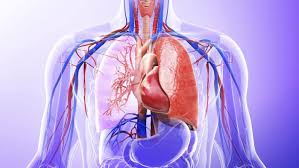Pneumonia: An infection
of the alveoli, usually by bacteria.
Tuberculosis: A slowly progressive pneumonia caused by the bacteria
Mycobacterium tuberculosis.
Emphysema results from damage to the fragile connections between alveoli.
Smoking is the usual cause. (Emphysema also limits airflow, affecting the
airways as well.)
Pulmonary edema: Fluid leaks out of the small blood vessels of the lung into
the air sacs and the surrounding area. One form is caused by heart failure and
back pressure in the lungs' blood vessels; in another form, direct injury to
the lung causes the leak of fluid.
Lung cancer has many forms, and may develop in any part of the lungs. Most
often this is in the main part of the lung, in or near the air sacs. The type,
location, and spread of lung cancer determines the treatment options.
Acute respiratory distress syndrome (ARDS): Severe, sudden injury to the lungs
caused by a serious illness. Life support with mechanical ventilation is
usually needed to survive until the lungs recover.
Pneumoconiosis: A category of conditions caused by the inhalation of a
substance that injures the lungs. Examples include black lung disease from
inhaled coal dust and asbestosis from inhaled asbestos dust.



 Contact Us
Contact Us







 Hospitals
Hospitals
 Doctors
Doctors
 Diagnostic
Diagnostic
 Pharmacy
Pharmacy
 Health Tips
Health Tips
 Blog
Blog

























Comments